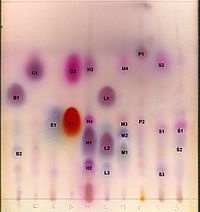Identification
There are 3 primary identification (ID) methodological approaches that are currently accepted by stakeholders involved in the Dietary Supplement industry:
- Chromatographic fingerprinting: High Pressure Liquid Chromatography (HPLC) and Gas Chromatography (GC) ID methods are highly respected techniques in the identification of Dietary Supplement bio-active ingredients because of the high degree of accuracy, precision, and significant global scientific consensus in its methodological applications. It is therefore a highly recommended technique by scientists and governments abroad. It is also a valuable way to both accurately quantify and ID the bio-active chemical constituent in various matrix types for one price unlike the more traditional TLC and IR methods.
- Microscopic cell morphology assay.
- Infra-Red methodology: IR testing for more than 250 bio-active botanical/herbal ingredients as well as common nutritional parameters and active pharmaceutical ingredients (API’s) depending on the physical/ chemical properties of the sample in question.
General Guidance for Microscopic Analysis;
Microscopic examination of powdered sample material is based on observation of specific microscopic characteristics that have been established for the specific dietary supplement or food ingredient. This analysis also is used to identify some adulterants.
Identification is based on microscopic observation of cell and tissue structures of plants and animals such as:
- Defined histological characteristics of plant parts (e.g. stems, roots and rhizomes, bark, leaves, flowers, seeds);
- Defined histological characteristics of animal tissues and cells;
- Defined staining or microscopic chemical reactions.
Identification is achieved by comparison of a representative sample from the commercial batch with authenticated or in-house working reference material, or authoritative technical descriptions of established microscopic characteristics.
Observation:
Preliminary organoleptic tests may be required prior to the microscopic analysis: note and describe the color, the odor, and the taste.
The analysis depends on microscopical recognition of characteristic tissue and cell types and cell contents. In-house primary/working reference material or an authoritative technical reference description is required to compare the observation to.
While microscopes can be used in the identification of ingredients, additional quality or purity data (e.g., contamination by mold, insect, rodent hair, microbe, and economic substitution) can also be obtained from microscopy.
It is possible that finely powdered material may obliterate microscopic characteristics. In this case, other tests such as chemical assays should be employed.
Documentation:
The observation can be documented by means of digital or optical photographs or by descriptions.
Microscopic analysis performance standards requirement
Qualified personnel:
- Personnel must be appropriately qualified to perform ingredient identification procedures including evaluation of supplier certifications, collection of wildcrafted herbs or botanicals, preparation of representative batch or lot samples, organoleptic determinations, microscopic examinations, and chemical analyses.
Qualified personnel have:
- Documented demonstration of knowledge, skills, and abilities pertinent to the position held;
- Knowledge gained through relevant academic studies.
Equipment and supplies:
Reliable laboratory equipment, appropriate reagents, representative samples, standard reference materials, and authenticated and in-house working plant reference materials are necessary to perform required assays.
Laboratory equipment and other apparatus (e.g., microscopes, sieves, slides, cover glasses, needles, and forceps) must be suitable to perform all required tests;
Laboratory equipment is calibrated at appropriate intervals and calibrations are documented;
Reagents and reference standards are of a quality and purity appropriate for the required tests;
Authenticated and in-house working plant reference materials are of a quality appropriate for the required tests.
Laboratory quality:
Laboratory certification is documented by appropriate accrediting organization if applicable, or by monitoring in-house quality assurance performance standards.
References:
US FDA Center for Food Safety and Applied Nutrition: Ingredient Identity Testing Records and Retention, June 1999
W. C. Evans: Pharmacognosy, 14th Edition, 542-578
Thin Layer Chromatography Identification:
TLC as a methodology is used to accurately identify (ID) high molecular weight, thermally labile, non-volatile solutes in mixtures.
Labstat offers TLC ID assays for more than 150 bio-active botanical/herbal ingredients as well as common nutritional parameters and active pharmaceutical ingredients (API’s).
Thin layer chromatography (TLC) is a traditional chromatographic technique that is used to identify bio-active ingredient mixtures by separating each bio-active ingredient and measuring its separation by its Rf Value.
TLC remains a highly respected identification technique in the Dietary Supplement Industry because of a long history of success with accuracy, precision, and significant global scientific consensus in its application. It is therefore a highly recommended technique by scientists and governments abroad.

Chromatographic fingerprinting Identification:
Chromatographic techniques such as Gas Chromatography (GC) and High Pressure Liquid Chromatographic (HPLC) technology are used to accurately and precisely quantify and identify (ID) organic compounds such as Dietary Supplement bio-active ingredient chemicals.
Labstat offers HPLC and GC assays for more than 250 bio-active botanical/herbal ingredients as well as common nutritional parameters and active pharmaceutical ingredients (API’s).
HPLC instrumentation is utilized for the quantification and ID those bio-active ingredients that are by nature polar, high molecular weight, thermally labile, non-volatile solutes in samples. Some common examples are the vitamins and bio-actives such as the ginsenosides in Ginseng roots.
GC instrumentation is utilized for the quantification and ID of non-polar (Lower polarity), lower molecular weight, volatile analytes in samples i.e. omega fatty acid EFA’s.
Infrared Identification:
Infrared (IR) spectroscopy measures how well a sample absorbs light at each wavelength thereby exhibiting a specific characteristic infrared spectrum.
Labstat offers IR testing for bio-active botanical/ herbal ingredients as well as common nutritional parameters and active pharmaceutical ingredients (API’s) depending on the physical/ chemical properties of the sample in question.
IR technology is categorized into 3 basic methodological techniques:
- Traditional Infra-Red- Dispersive and monochromatic,
- Near Infra-Red (NIR)- Dispersive and monochromatic,
- Fourier Transform Infrared spectroscopy (FTIR)- Polychromatic
The following table illustrates the wavelength ranges that decide which technique is best for the particular bio-active ingredient: (NEW TABLE TO GO BELOW)
| Designation | Abbreviation | Wavelength |
|---|---|---|
| Near-Infrared | NIR | 0.78–3 µm |
| Mid-Infrared | MIR | 3–50 µm |
| Far-Infrared | FIR | 50–1000 µm |
IR instrumentation methods are limited to samples that constitute high purity or high homogeneity sample types.
